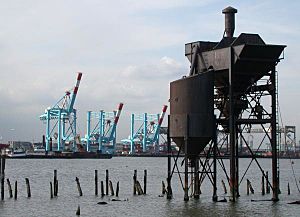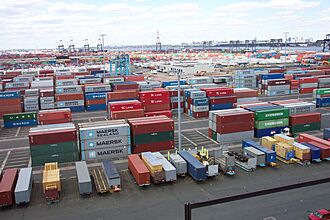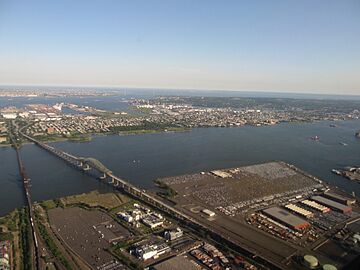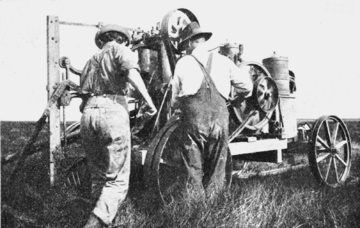Port Newark–Elizabeth Marine Terminal facts for kids
Quick facts for kids Port Newark–Elizabeth Marine Terminal |
|
|---|---|
 |
|
| Details | |
| Draft depth | 50 feet (15 m) |
| Air draft | 215 feet (66 m) (Bayonne Bridge) |
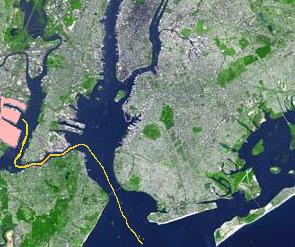
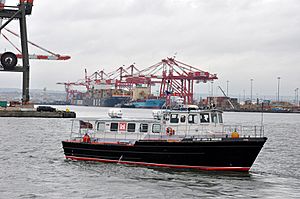
The Port Newark–Elizabeth Marine Terminal is a really important part of the Port of New York and New Jersey. It's the main place where huge container ships bring goods into and take goods out of the New York metropolitan area and the northeastern part of North America.
This big port is located on Newark Bay. It's managed by the Port Authority of New York and New Jersey. The port is actually made up of two parts: Port Newark and the Elizabeth Marine Terminal (sometimes called Port Elizabeth). They are right next to each other in the cities of Newark and Elizabeth, New Jersey. You can see them easily from the New Jersey Turnpike and Newark Liberty International Airport.
Contents
How the Port Works
This port is one of the busiest on the U.S. East Coast. It's also one of the largest in the whole country.
Giant container ships arrive at the port by sailing through The Narrows and the Kill Van Kull. These waterways lead into Newark Bay. Newark Bay is a shallow area, but it has been made deeper so that very large ships can use it. Some ships also come into Newark Bay through the Arthur Kill.
The port has special areas where ships can dock and many large cranes. These cranes lift the shipping containers off the ships. You can see huge stacks of these containers from the New Jersey Turnpike. After being unloaded, the containers are put onto rail cars or trucks to be sent to different places.
The amount of goods handled by the port has grown a lot. For example, in 2006, it handled more than 20% of all goods imported into the US from Germany. That was more than any other US port!
Some of the main companies that operate at the port include Maher Terminals, APM Terminals (which is part of A. P. Moller-Maersk), and Port Newark Container Terminal.
Making the Port Better
The port is always being improved to handle more and bigger ships. For example, new cranes were added in 2014.
One challenge for the port was the Bayonne Bridge over Kill Van Kull. This bridge limited how tall ships could be when entering the port. This became a bigger problem when the Panama Canal was expanded in 2016. The expansion allowed bigger ships, called New Panamax ships, to travel from Asia to the port.
To solve this, the Port Authority decided to raise the roadway of the Bayonne Bridge. This huge project cost about $1.7 billion. The bridge was made taller in June 2017, and the whole project finished in 2019. Now, taller ships can pass underneath! Other improvements costing billions of dollars are also planned. These include even larger cranes, bigger rail yards, deeper shipping channels, and expanded docks.
Rail Connections
The port has excellent rail connections, which are very important for moving goods. ExpressRail, a program by the Port Authority, allows containers to be moved directly from ships to trains at both Port Elizabeth and Port Newark.
Conrail Shared Assets Operations connects the port's rail lines to bigger rail networks. This allows goods to be sent across the country by train.
There are also special facilities at the north end of Port Newark for processing cars. These areas have their own train tracks right at the docks. Large rail yards, like Oak Island Yard, are also nearby to help organize all the train traffic.
Port History
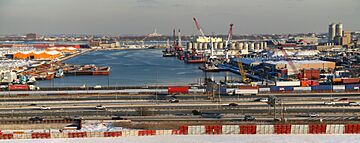
The area where Port Newark is now used to be a large, shallow wetland called the Newark Meadows. In the 1910s, the city of Newark started digging a shipping channel here. This was the beginning of Port Newark. Work on the channel and the port facilities sped up during World War I. The government even took control of the port, and nearly 25,000 troops were stationed at the Newark Bay Shipyard during the war.
After the war, shipping slowed down. In 1927, the city of Newark began building Newark Airport (now Newark Liberty International Airport) on another part of the wetlands near the port. In 1948, the Port Authority of New York and New Jersey took over both Port Newark and Newark Airport. They started making both places more modern and expanding them.
A very important event happened on April 26, 1956. The SS Ideal X, which is considered the first container ship, made its first trip carrying 58 containers from Port Newark to the Port of Houston. This was a big deal because it changed how goods were shipped around the world. A company called SeaLand then expanded its operations at the new container terminal.
In 1958, the Port Authority dug another shipping channel. This channel helped create new land where the Elizabeth Marine Terminal was built. The first shipping facility to open on this new channel was the Sea-Land Container Terminal. This terminal became a model for almost every container terminal built after it.
These new, modern port facilities changed shipping in New York Harbor. They made many older, traditional ports in places like Manhattan, Hoboken, and Brooklyn less busy. The new automated way of handling containers meant that fewer workers were needed, and containers didn't need to be opened until they reached their final destination.
In 2011, the Port Authority made a new agreement with a major tenant, Port Newark Container Terminal (PNCT). This agreement means PNCT will invest $500 million and expand its area. This expansion is expected to greatly increase the number of containers handled by the port, especially from the Mediterranean Shipping Company. To handle this growth, plans include making the Kill van Kull deeper, raising the Bayonne Bridge even more, and expanding the rail freight facilities.
In July 2023, a ship carrying nearly 1,200 vehicles caught fire at the port. This caused a large emergency response.
Other Port Facilities
The Port Authority of New York and New Jersey also manages other important seaport terminals, including:
- Red Hook Marine Terminal on Upper New York Bay
- Howland Hook Marine Terminal on Arthur Kill at Newark Bay
- Port Jersey Marine Terminal on Upper New York Bay
|


